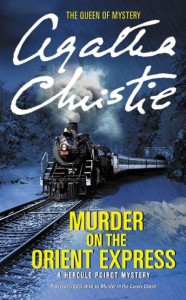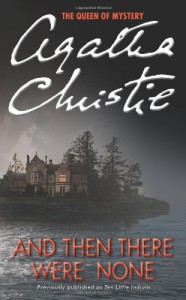6. Murder on the Orient Express
 “A passenger was traveling with Taurus Express.
“A passenger was traveling with Taurus Express.
One winter morning, it was unusually cold in these parts of Syria. It was five o’clock. Over the station platform Aleppo there was a train waiting for the starting signal, recorded in a lame way on the railway guide: Taurus Express.
The sets consisted of a restaurant wagon with a kitchen, one bedroom and two race cars.
On the platform, in the door sleeper, two men were talking: a brilliant young French lieutenant in uniform, and a little man covered and cocooned from ear to ear, from which one could see the red tip of the nose and the twisted upwards mustache.”
“Murder on the Orient Express” by Agatha Christie is a real treat for novels lovers, detective or any other convoluted scenarios that are attempting to discover the truth or the accomplishment of a crime.
It’s a story as similar to hundreds of other topics of this kind of crime, but more impressive and unique. With an outcome that causes you rather to smile, when you realize, more than in other states most appropriate for such situations.
The Plot
All of the book’s action takes place on a train. Detective Hercule Poirot is called urgently to London in connection with solving a case, the command to reserve a berth in that train to reach its destination as quickly as possible. He noted that the station of the sleeping car compartment where he was assigned to was overly full.
The very first night after starting the train, in a car near the berth of the detective Poirot was, had found a body. An American named Ratchet, stabbed in several places 12-15 times with a dagger. As the train stopped in Yugoslavia, because of an unexpected blocking, the situation is to be put somehow to unravel the mystery of this murder.
Detective Poirot takes upon himself the responsibility of finding out who is the murderer, indicating that in his research in a wagon trail to Calais, Istanbul. Around 12 passengers were properly accounted by the Detective: ladies and gentlemen of various nationalities, social positions and temperaments. The killer could be anyone of them.
An interesting twist says that Poirot discovered who the murderer was in the person of guy called Cosset, who hides his identity, involved in several cases of kidnapping of children. Gradually, Poirot discovers multiple identities in the wagon because they all had reasons to kill the murderer in question.
https://www.youtube.com/watch?v=u0ykCP1AYlk
5. Miss Marple’s Last Cases
 “I really cannot understand the point of what you’re saying. Really,’ said Clotilde, looking at her. ‘What a very extraordinary person you are. What sort of a woman are you? Why are you talking like this? Who are you?’
“I really cannot understand the point of what you’re saying. Really,’ said Clotilde, looking at her. ‘What a very extraordinary person you are. What sort of a woman are you? Why are you talking like this? Who are you?’
Miss Marple pulled down the mass of pink wool that encircled her head, a pink wool scarf of the same kind that she had once worn in the West Indies.
‘One of my names,’ she said, ‘is Nemesis.’
‘Nemesis? And what does that mean?’
‘I think you know,’ said Miss Marple. ‘You are a very well educated woman. Nemesis is long delayed sometimes, but it comes in the end.”
Nine stories bearing the signatures of the famous Agatha Christie form a thin little nove. Two of whom do not have the nice old and extremely intelligent lady as principal investigator, so to speak. “The doll” and “In the mysterious mirror” have, actually, a paranormal character and in no way are part of the patterns with which she has accustomed us in her novels, but this does not diminish all of the beauty of the reading.
The Stories
The story briefly presents the last cases of Miss Marple, the usual Miss Marple offering us her business agility, spirit of observation and her ability to make comparisons with trivial events in the little village of St Mary Mead, comparisons that have no other purpose than discovering more complicated perpetrators in cases that are brought to their attention.
“ Briefly presents the last cases of Miss Marple ”
The first story is entitled sanctuary and presents the case of a church, in the small village of Chipping Cleghorn. Nobody knows why she precisely chose to seek that sanctuary in the church in particular, but the hints say that her relatives will be killed. The vicars wife, who found the dead body, called her aunt for help, her aunt being no other than Miss Marple.
The novel is yet another funny story of heirs in which she finds another way to discover the wealth left by her predecessors, and for that she asks for the help of Miss Marple. Will it be really quite insightful to find a considerable fortune hidden away? In “The Crime”, the crime committed with the help of a tailoring meter, the situation seems quite clear even from the title.
But did it and especially, why? The next Miss Marple story has more of an advisory role, as Dr. Haydock has already solved the mystery. But he took the long way, following a hard and tortuous road, while Miss Marple was simply having fun to hear how the crazy caretaker managed to kill the young wife of the new owner.
The next case exposes the ingenuity of the characters when they want to do something bad, assuming other people’s goods as their own. Fortunately there was Miss Marple, acting promptly when investigators were in deadlock.
Miss Marple’s storytelling is the only time Miss Marple acts as a narrator. It has a peculiar style in situations where the story has made deductive contribution to the spirit to get to the bottom of a complicated case. Here, the mystery of a dead body locked inside a room is revealed.
The last of the stories that involves Miss Marple’s is the “Greenshaw’s craziness”. Even with the last of our old situations it is not nice to be outdone and the story gives the feeling of a highly intricate end, as tangled as the architecture of the house in which it takes place.
4. And Then There Were None
 “Ten little Indian boys went out to dine;
“Ten little Indian boys went out to dine;
One choked his little self and then there were nine.
Nine little Indian boys sat up very late;
One overslept himself and then there were eight.
Eight little Indian boys travelling in Devon;
One said he’d stay there and then there were seven.
Seven little Indian boys chopping up sticks;
One chopped himself in halves and then there were six.
Six little Indian boys playing with a hive;
A bumblebee stung one and then there were five.
Five little Indian boys going in for law;
One got in Chancery and then there were four.
Four little Indian boys going out to sea;
A red herring swallowed one and then there were three.
Three little Indian boys walking in the Zoo;
A big bear hugged one and then there were two.
Two little Indian boys sitting in the sun;
One got frizzled up and then there was one.
One little Indian boy left all alone;
He went and hanged himself and then there were none.”
Ten people are invited by an unknown U.N. member, on the Island of Black, a mysterious property near Devon. What seemed at first as a simple holiday soon turned into a nightmare, in which ten people are killed one by one according to a poem for children, “Ten black niggers.“
Each of the ten is accused of having committed a crime that can not be brought to justice. This way Dr. Armstrong killed a patient on the operating table, Miss Brent murdered the maid, Inspector Blore killed a man accused of murder, secretary Claythorne drowned a child, Captain Lombard has caused the deaths of two natives, General Macarthur killed a subordinate, Marston fatally injured two young children, the Rogers have left an old woman who they had in care to die, and Judge Wargrave condemned a prisoner to death.
After the first deaths on the island, the men decide to go and find where the killer was hiding. After realizing that there is no place where the murderer could hide, the people begin to suspect each other, only trusting in themselves.

